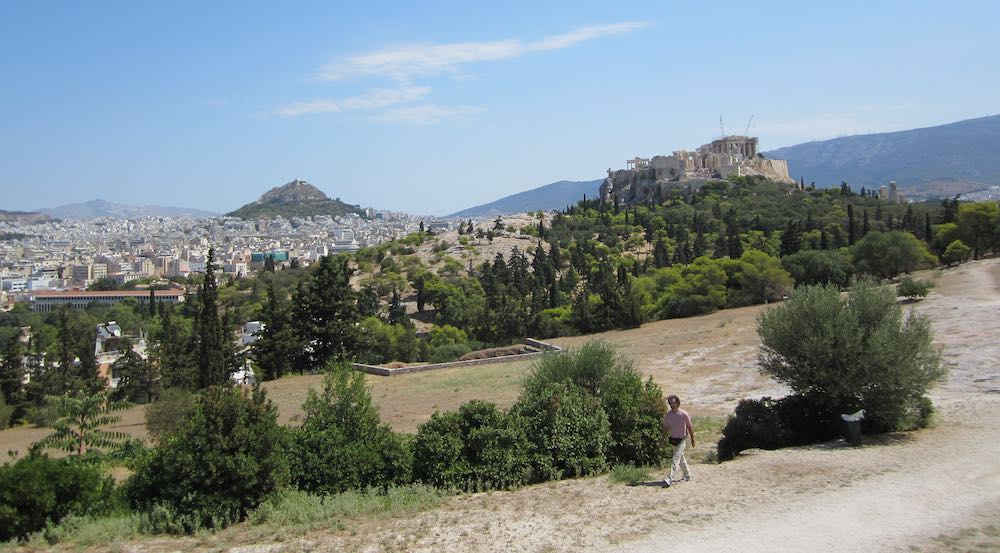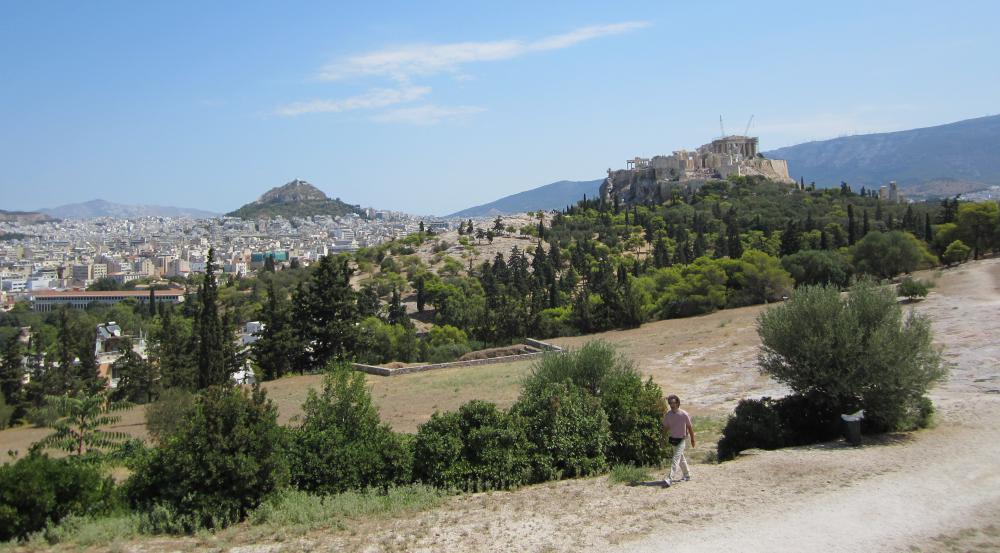
Category of Astronomical Heritage: tangible immovable
The Pnyx, Athens, Greece

Presentation
Geographical position
Roughly 300m west of the Acropolis, Athens, Greece.
Location
Latitude 37° 58′ 18″ N, longitude 23° 43′ 10″ E. Elevation 97m above mean sea level.
General description
The Pnyx is an elevated area within ancient (Classical) Athens. Until late in the Classical period it was the usual place of assembly for political meetings, and for this reason its principal significance is usually held to be its association with the development of democracy. Its significance to the history of astronomy is due to the erection there by the astronomer Meton of an instrument named the heliotropion, whose name suggests that it was connected with observations of the solstice. It is likely that the observations themselves made use of a natural horizon foresight on nearby Mount Lykabettos. These observations helped Meton identify his famous calendrical cycle, based on the fact that 19 solar (tropical) years are very close indeed to (i.e. within about 2 hours of) 235 lunar (synodic) months.
Brief inventory
The place where Meton observed is an almost flat area that was enhanced and enlarged artificially, and occasionally remodelled, explicitly for this purpose.
There is no trace of the heliotropion and we do not know what form it took. However, identifying when the solstice occurs using only a self-contained instrument would have been very difficult, because the sun’s declination changes extremely slowly close to the solstice. It is likely, therefore, that such observations made use of distant markers, effectively magnifying the scale of the ‘instrument’. The view from the observing site on the Pnyx does in fact contain a natural marker in the form of Mount Lykabettos, a hill some 3km away rising to an elevation of about 300m. This northern flank of this hill presents an angular profile interrupting the skyline at the point where the midsummer sunrise occurred. One portion of this profile is steeper than the path of the rising Sun, raising the possibility that there was a particular spot from which the very edge of the sun was seen to ‘flash’ only on, or very close to, the day of the solstice. Investigations are ongoing to see if such a spot exists within the area now regarded as the Pnyx. In that case it is possible that the heliotropion was simply a marker post or column, forming a backsight and marking the observing spot.
History
According to historical sources, Meton made observations of the summer solstice here in 432 BC. The site was reused for astronomical observations from 1890, when the National Observatory of Athens’ 40cm Gautier equatorial refractor dome was constructed here.
Cultural and symbolic dimension
Observations of the summer solstice had a local civic significance, in that the year of the Athenian civil calendar began at the first New Moon following the solstice.
Authenticity and integrity
No trace remains of the instrument used by Meton, nor of any contemporary building or structure. However, the natural horizon formed by Mount Lykabettos, which may well have been vital to Meton’s observations, is unaltered.

Fig. 1. View of the Pnyx with Mount Lykabettos in the background. Photograph by Tomisti, Wikimedia Commons, Creative Commons Licence
Documentation and archives
The fact that Meton placed his heliotropion on the Pnyx is mentioned in a commentary on the comedy The Birds by Aristophanes. In the play, Meton is held up to ridicule and must therefore have been a well-known figure when it was written, in 414 BC. An inscription from Miletus, Ptolemy (Almagest 3.1), and Diodorus Siculus (Library of History 12.36.1-2) all record Meton’s observation of the summer solstice in 432 BC. Diodorus Siculus tells us that Meton instituted his well-known calendrical cycle, according to which 19 years contain 235 synodic months, from that event.
Management and use
Present use
The site is open to the public. There is provision for official supervision during the day, and visitors usually enter the site along a built path and through a gate; but no fee is charged and it appears that the gate is not shut at night. In fact, one can walk past the end of the fence that partly separates the archaeological site from the surrounding area where there are larger shrubs and trees. Residents of the surrounding neighbourhoods walk freely over the whole area for recreation.
Context and environment
The Pnyx itself is largely cleared of vegetation other than grass and small shrubs. Since its former use depended on the area being cleared, the present general appearance of the area is presumably similar to that which it had in antiquity.
Archaeological / historical / heritage research
Several historical sources affirm the use of this place by Meton for solstitial observations. There is also good archaeological evidence to demonstrate the artificial shaping of the area for Meton’s observations.
Management, interpretation and outreach
In common with all significant Greek archaeological sites, the Pnyx is the property of the state. The flat area where Meton observed has been exposed and is presented to visitors using discreet labelling.
No multimedia content published
Currently there is no multimedia content published for this case study






